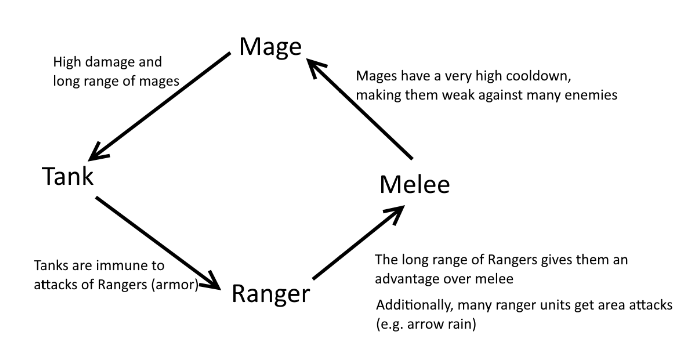merkutsam said:
I prefer different types of damage and defense.
I mean instead of tanks based on hit points, I prefer them based on good defense against the normal attack but vulnerable to another attack. Ex: infantry with armor and shields is a good tank against arrows, but less effective in melee than pikes. While pikes are better in melee but vulnerable to arrows. Here you have two different melee units, each one with different strengths and weaknesses. I like to base design on reality as much as possible. If you base tanks on hitpoints it needs a counter based on percentage of health which is another unrealistic design. It can be a good game but I prefer the other way.
I get your point and this is, for sure, something worth to consider. If we would, for example, go with Tanks that take only very little damage from attacks of Rangers, that would be an example of this design paradigm.
King Mir said:
- Your second RPS diagram looks fine. Make it so a tank can kill a melee unit in an integer number of hits exactly, to balance them.
- The problem with a melee hero, is that the strength of melee is numbers. If you have a more expensive melee unit that's harder to kill, that starts to look like a tank. You might be able to have units that buff melee, but they'd need to have low hp. I guess you could still have a tank that buffs melee, balanced by a melee unit that buffs tanks, like a week support unit.
- Speaking of support units, they can encourage specialization in one unit type is to have support units that boost only that unit type. That's probably a better mechanic over all than just “I have lots of mages so my mages are stronger”.
- One advantage that cheap weak troops generally have is that you can ramp them up slower. So you might start with a tank, expect the enemy to counter with mages, then instead of sending a tanks cost of melee units together, you can start sending units as soon as you can afford a single one. Because of this, I do like the idea of not making melee part of the main rps loop. However, just making rangers be the only thing that's good against them encourages a strategy of using a lot of melee. What you can instead do everyone equally good against melee. That means no area attacks by your main three.
- Making melee week against everyone, and having heroes is also nice because then you have three tiers of units, with three tiers of cost. You could even make this another RPS layer, if you make melee good against heroes.
- Making melee good against buildings seems a bit strange to me from a realism perspective, unless you give them a special anti-building ability, like sapping underground or explosives. Plus there are more realistic anti-siege weapons.
- The formation system sounds good, but that only makes sense for the front, not for units trying to reach the front. So fast units still have an advantage reaching the front. So you'd want to make them a tad weaker to compensate.
- Yeah damage types are great, but you'd need to increase the total number of unit types to make it work. So if you're keeping the unit numbers small, then I agree you should keep it out.
- I don't agree that percentage of hit points are a particularly unrealistic mechanic. It's basically a way to represent a unit that overcomes armor. To such a unit, an unarmored foot soldier or a fully clad knight look like they take the same amount of hits. It's suitable for a unit that deals blunt damage.
- If you don't have area attacks to counter melee, you can still have attacks that target a fixed multiple of units: double attacks, and triple attacks.
- Thanks for the hint regarding balancing melee und tank units
- I'll write a separate section about our thoughts regarding heroes in the bottom
- We consider the following solution regarding “advantage when you have many units of the same type”: When the player has 3 units of a kind in his formation, a support unit (similar look, but carrying a banner which displays the unit class, e.g. ranger, mage or melee) is automatically spawned and will join the units. It will stay alive, even if the 3 units are killed, until enemies kill this support unit. If the player should have 6 units of a kind, a second support unit is automatically spawned. The support units boost all units of the same class of the player
- Yeah, all unit classes would be equally good against melee, except ranger who would be naturally effective against melee due to their long range (and their cooldown is not as high as the mage cooldown)
- Making melee strong against heroes is a good idea
- I agree and siege machines are cool anyways (and add this additional timing aspect)
- Already the case: only the units on the front form a formation (which adapts to the speed of the slowest unit) and other units walk on their own
- I'll comment on this one down below.
- That would be one way to explain it. Additionally, through an armor system (e.g. no/medium/strong armor against regular attacks or against magic attacks; the damage dealt to a unit would be attack damage minus armor value) this could be realized too: an attack that ignores armor would have a similar effect
- This is what we are probably going to do
Now, there a few more open topics:
Heroes
Because of the formation system, units choose a position in the 1d army formation, which is suitable for their unit class. A tank will be in the front, next will be melee, ranger, mage. Most enemy attacks target the front unit of the formation. Assuming we keep it this way (an alternative would be just keeping the order in which units are built), it might be overpowered, if a Hero would choose a position in the back.
Why do I mention this?
We could put heroes into one of the unit classes (mage, ranger, possibly melee). If we do this, it would be reasonable if a mage hero would choose a slot in the back, have a huge amount of damage and rather low health (for a hero). Due to the hero having a slot in the back, if it would be protected with tanks in the front, it could deal huge amounts of damage, without taking any damage itself (position in back). Of course, this needs to be playtested, but I feel like this could be overpowered.
An alternative would be putting all heroes in the front of the formation, however that does not feel right, if we decide to go with mage or ranger Heroes, instead of just one tank-like hero class.
Unit speed and buildings
Currently, we have the “attacks destroy each other" option activated (e.g. an axe could destroy an arrow or a fireball a spear), I have talked about this in a previous post. Because of that, the player wants to have an army with as much firepower as possible. Due to that, it is actually positive for the player to have an army, which moves slowly. Walls, that block the army, are welcome, because they slow the army down, giving it more time to grow bigger and stronger. This defeats the purpose of the wall. If the health of buildings would be increased and only a few special siege machines can take buildings down quickly, it would increase this effect even more.
I have not played any game of this kind yet, which used buildings, such as walls. Maybe, because they are really difficult from a game design perspective (chances are that there are such games, which I just do not know). If the “attacks destroy each other" option is deactivated, the effect is not as big (but still exists). I like that option though, because, at least without a proper RPS unit class design, the game felt boring without this option and feels fun with the option (but is harder to balance).
Many different unit types
We have talked a lot about unit classes already (e.g. hero, tank, melee, ranger, mage). Every unit is in one of those classes. However, this does not mean, that there are only 5 unit types: Every single faction/tribe has a unique set of 5 unit types. Examples: the goblin tribe has a goblin boss, a goblin tank, etc. The dwarf tribe has a dwarf boss, a dwarf tank, etc. All those individual unit types are based on the 5 main unit classes, yet they have a few minor differences, such as
- their attack (e.g. golden spear vs mad boomerang vs god axe)
- mount / no mount
- rarity (common, rare, epic, legendary). The rare a unit type is, the higher the stats are but the more expensive it is
- optionally vampire effect (regain some health via damaging enemies)
- a few more differences (for example higher attack rate but lower damage)
My main goal is, to balance the 5 unit classes. The individual unit types should feel a little bit different too, but I am fine with them having just minor differences. I understand, that it is, basically, not managable, to create over 50 unique, well-balanced unit types.
After having put some more time into playtesting and balancing the 5 unit classes, I will think about the possibility to introduce different armor levels (as mentioned in my response to point 9).
Btw.: I really appreciate your time and your help ? Thank you!










